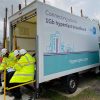Project Gigabit Updates on Start of First Live UK Procurements

The UK Government’s Building Digital UK team has published an update on the start of their first procurements under the £5bn Project Gigabit broadband rollout, which is now inviting bids for contracts worth up to £292m to upgrade rural premises across Cumbria, Durham, Northumberland, Cambridgeshire, Dorset and Teesdale.
Project Gigabit seeks to extend 1Gbps capable networks to reach at least 85% of UK premises by the end of 2025 and then universal coverage by around 2030 (here and here). The funding released for this will depend upon how the industry responds. So far only £1.2bn has been released from the budget up until 2024, but more may be unlocked, provided the industry shows it can deliver.
At present around 65% of UK premises can already access a gigabit-capable network (c.30% via just FTTP) and that’s mostly thanks to Virgin Media’s upgrade of their existing HFC lines (here). Generally, it’s hoped that commercial builds could push gigabit coverage up to c.80% (mostly in urban areas), but public funding will then be needed to tackle the rest due to the disproportionately high cost of deployment.
Advertisement
The new project is thus designed to focus on improving connectivity for those rural and semi-rural areas in the final 20% (5-6 million premises). This consists of several support schemes, including gigabit vouchers (£210m), funding to extend Dark Fibre around the public sector (£110m) and gap-funded deployments with suppliers or GIS (rest of the funding).
Today’s article is focused upon the latter gap-funded solution – the Gigabit Infrastructure Subsidy (GIS), which sees ISPs bidding – via a new Dynamic Purchasing System (DPS) run by BDUK – to extend their networks across rural parts of the UK.
Progress so far
The first procurement phase (Phase 1a) was announced in March 2021 and, after a few revisions, that covered parts of Cumbria, Cambridgeshire, Durham (inc. Tyneside and Teesside areas and Northumberland), Cornwall and Isles of Scilly. Some 234,000 premises will also be tackled in Wales as part of the wider project (here).
The Phase 1b and Phase 2 procurements then followed in August 2021 (here), which targeted 480,000 premises across Shropshire, Norfolk, Suffolk, Worcestershire, Hampshire, the Isle of Wight, Derbyshire, Wiltshire, Gloucestershire, Lancashire, Surrey, Leicestershire, Warwickshire, Nottinghamshire, Hertfordshire, Staffordshire, Lincolnshire and Yorkshire.
Advertisement
After that, Phase 3 was unveiled in October 2021 (Autumn Update), which aimed to cover 570,000 premises across parts of Cheshire, Devon, Dorset, Somerset, Essex, Herefordshire, Gloucestershire, Lincolnshire, East Riding and North Yorkshire. At the time of the Phase 3 update, only Cumbria had actually progressed to the stage of opening up for bids from potential suppliers (i.e. live procurement).
The big news today is that Cambridgeshire, North East England, North Northumberland, Teesdale and North Dorset have now also moved into the live procurement phase. Including Cumbria, this reflects a potential upgrade for up to 187,000 rural premises, with a total indicative contract value of £292 million.
Live Procurements (Q1 2022 Update)
| Local or Regional Supplier procurement | Area/Lot Number | Procurement start date | Estimated contract commencement date | Estimated number of uncommercial premises in the procurement area | Indicative Contract Value |
| Local | North Dorset (Lot 14) | 05/01/2022 | 08/08/2022 | 7,100 | £11.0m |
| Local | North Northumberland (Lot 34.01) | 11/01/2022 | 08/08/2022 | 3,900 | £7.3m |
| Local | Teesdale(Lot 4.01) | 11/01/2022 | 08/08/2022 | 4,100 | £6.6m |
| Regional | Cumbria (Lot 28) | 20/10/2021 | 06/09/2022 | 60,800 | £109.2m |
| Regional | North East England (Lot 4) | 18/01/2022 | 24/11/2022 | 61,800 | £89.6m |
| Regional | Cambridgeshire and adjacent areas (Lot 5) | 07/01/2022 | 17/11/2022 | 49,700 | £68.6m |
Naturally, the ‘estimated’ details above are subject to change (final contract decisions often have a significant impact). In addition, once a contract has been awarded, you typically have to allow several months for final engineering surveys and other things to take place, before the physical build itself can begin. In other words, nearly all of the above procurements won’t enter build until early 2023 or later.
Advertisement
We should add that local supplier procurements tend to be focused toward smaller operators (e.g. alternative networks) or projects, while regional procurements are aimed more at operators with “substantial operational capacity and financial backing” (e.g. Openreach, Virgin Media, CityFibre etc.).
In terms of the ongoing discussions with the devolved administrations in Northern Ireland and Scotland, it still remains unclear precisely how Project Gigabit’s funding will be apportioned and managed. But preparatory work is now underway to launch a gigabit Open Market Review (OMR) for Scotland in the “coming weeks” (used to identify the intervention area for state aid), which is the first step on the way to procurement. A similar OMR is due to follow for N.Ireland sometime in 2022, but there’s no solid date yet.
Finally, the latest update also includes an updated list of the forthcoming procurement pipeline, which reflects some of the other areas across Phases 1-3. Areas marked with * below reflect those that are still under consultation with the market about the suitability of further Local Supplier procurements, which could complement the need for Regional Supplier procurements.
Forthcoming Procurements
| Local or Regional Supplier procurement | Area/Lot Number | Procurement start date | Estimated contract commencement date | Estimated number of uncommercial premises in the procurement area | Indicative Contract Value |
| Local | Lot 32 Cornwall and Isles of Scilly | Feb – Apr 2022 | Sep – Nov 2022 | 9,700 | £18m – £24m |
| Local | Lot 32 Cornwall and Isles of Scilly | Feb – Apr 2022 | Sep – Nov 2022 | 9,900 | £18m – £24m |
| Regional | Lot 7 Norfolk | Feb – Apr 2022 | Jan – Mar 2023 | 111,400 | £115m – £195m |
| Regional | Lot 2 Suffolk | Feb – Apr 2022 | Jan – Mar 2023 | 86,100 | £89m – £151m |
| Regional | Lot 27 Hampshire* | Mar – May 2022 | Jan – Mar 2023 | 148,100 | £148m – £251m |
| Regional | Lot 25 Shropshire* | Mar – May 2022 | Jan – Mar 2023 | 64,300 | £61m – £104m |
| Regional | Lot 24 Worcestershire | May – Jul 2022 | Apr – Jun 2023 | 45,600 | £50m – £84m |
| Regional | Lot 13 Oxfordshire and West Berkshire | May – Aug 2022 | Apr – Jun 2023 | 67,000 | £67m – £114m |
| Regional | Lot 29 Kent | May – Jul 2022 | Apr – Jun 2023 | 109,500 | £119m – £203m |
| Regional | Lot 26 Buckinghamshire, Hertfordshire and East of Berkshire | May – Aug 2022 | Apr – Jun 2023 | 137,100 | £140m – £237m |
| Regional | Lot 19 Staffordshire | May – Aug 2022 | Apr – Jun 2023 | 70,800 | £72m – £123m |
| Regional | Lot 1 West Sussex | May – Aug 2022 | Apr – Jun 2023 | 56,700 | £66m – £112m |
| Regional | Lot 16 East Sussex | Aug – Oct 2022 | Jul – Sep 2023 | 41,200 | £49m – £83m |
| Regional | Lot 12 Bedfordshire, Northamptonshire and Milton Keynes | Aug – Oct 2022 | Jul – Sep 2023 | 81,300 | £84m – £144m |
| Regional | Lot 3 Derbyshire | Aug – Oct 2022 | Jul – Sep 2023 | 57,000 | £64m – £110m |
| Regional | Lot 30 Wiltshire and South Gloucestershire | Aug – Oct 2022 | Jul – Sep 2023 | 84,800 | £85m – £145m |
| Regional | Lot 9 Lancashire | Aug – Oct 2022 | Jul – Sep 2023 | 82,000 | £90m – £153m |
| Regional | Lot 22 Surrey | Aug – Oct 2022 | Jul – Sep 2023 | 99,400 | £101m – £171m |
| Regional | Lot 11 Leicestershire and Warwickshire | Nov 2022 – Jan 2023 | Oct – Dec 2023 | 112,900 | £114m – £194m |
| Regional | Lot 10 Nottinghamshire and West of Lincolnshire | Nov 2022 – Jan 2023 | Oct – Dec 2023 | 89,700 | £90m – £152m |
| Regional | Lot 8 West Yorkshire and parts of North Yorkshire | Nov 2022 – Jan 2023 | Oct – Dec 2023 | 125,200 | £128m – £218m |
| Regional | Lot 20 South Yorkshire | Nov 2022 – Jan 2023 | Oct – Dec 2023 | 56,800 | £59m – £103m |
| Regional | Lot 17 Cheshire | Feb – Apr 2023 | Jan – Mar 2024 | 74,300 | £85m – £144m |
| Regional | Lot 6 Devon and Somerset | Feb – Apr 2023 | Jan – Mar 2024 | 159,600 | £198m – £337m |
| Regional | Lot 15 Herefordshire | Feb – Apr 2023 | Jan – Mar 2024 | 23,700 | £30m – £60m |
| Regional | Lot 18 Gloucestershire | Feb – Apr 2023 | Jan – Mar 2024 | 44,700 | £40m – £80m |
| Regional | Lot 14 Dorset | May – Jul 2023 | Apr – Jun 2024 | 56,500 | £62m – £105m |
| Regional | Lot 21 Essex | May – Jul 2023 | Apr – Jun 2024 | 78,400 | £79m – £135m |
| Regional | Lot 23 Lincolnshire (including NE Lincolnshire and N Lincolnshire) and East Riding | May – Jul 2023 | Apr – Jun 2024 | 105,700 | £106m – £180m |
| Regional | Lot 31 Northern North Yorkshire | Aug – Oct 2023 | Jul – Sep 2024 | 28,200 | £25m – £42m |
The fact that some of these won’t enter contract commencement until late 2024 is a concern as, by that point, several long years will have passed due to the admin side before some areas even reach the build phase. Some of these contracts will thus only start to build in 2025, which is the same year that Project Gigabit originally set for achieving the 85%+ target (thanks to commercial builds, the Government will probably still achieve that).
We should remind readers that this rollout is NOT an automatic upgrade, thus you will still need to order the service from a supporting ISP (1Gbps is the target speed, but slower and cheaper options will also exist to order). In addition, no specific network coverage checkers will be available for areas in this programme, at least not until AFTER the contracts have been awarded and the necessary engineering surveys completed.
Mark is a professional technology writer, IT consultant and computer engineer from Dorset (England), he also founded ISPreview in 1999 and enjoys analysing the latest telecoms and broadband developments. Find me on X (Twitter), Mastodon, Facebook, BlueSky, Threads.net and Linkedin.
« Vodafone UK Updates on Changes to Roaming and Basics Plans UPDATE























































When the Government minister appears on the news saying how their Project Gigabit investment is seeing great results with whatever percentage of the country now able to access Gigabit/Full Fibre, I presume it would be true to say that not a single property has yet been connected to Gigabit/Full Fibre under that ~£5BN project funding yet, because it’s only today that the first invitations to even bid on the chance to get a contract for a slice of the money.
@SM the first gigabit-capable infrastructure was subsidised in Cornwall in 2011.
The ‘superfast’ contracts started delivering gigabit-capable full fibre from about 2014. The £1.7bn budget would be split £600m-£700m for ~38,000 cabs (before clawback) and the rest for full fibre in-fill which is still continuing. Full fibre is needed 1200m beyond the cab so the minimum of 30Mbps can be met.
The new process has yet to start, the old process is far from finished and much more could be squeezed from it. In August 2021 BT shareholder services confirmed to me £568m of clawback owed and capitalised was ‘untriggered’. This is no longer reported and BDUK have not published a reconciliation of who paid what and when.
This is now a 100% Boris Broadband sh*t-show (IMHO) and thus the upside to complete very rural upgrades is likely to be lost.
Thanks. I understand that equipment that is gigabit capable has already been deployed, as part of previous schemes, but I’m specifically questioning the Project Gigabit. The minister appears on the TV stating how their project and funding is speeding up the rollout and that we’re already at whatever percentage thanks to the project. But, as of today, not a single property actually connected as not a single property covered by a single contract to supply as part of the project yet as the bidding for those only begins today.
It’s all painfully slow.
@SM Your correct. The new contractual process has not been used. This is a good thing in my opinion for the reasons stated above.
The incremental benefit to the taxpayer of paying for those already on 30-80Mbps services to be able to order a >100Mbps service is not clear, especially if this is being done at the expense of those who so far are excluded from the process. The latter to date are not being prioritised in any of the consultations I have read.
Furthermore the re-use of capitalised clawback is being ignored. However it is capitalised and thus included in BT/OR cost recovery.
Given the sum of the indicative contract values above provide a range of between £2.4bn to £4.1bn and there is £1.6bn to contract against before 2025 (subject to business case), I assume there is no expectation that most of this work will begin before 2025 when the funds subject to political change become available.
The Think Broadband numbers for Jan 22 highlighted ~667k premises in England with 100Mbps is yet to be proven.
Competition should be possible when overbuilding 30-80Mbps FTTC, the backhaul is in place and network build has a radius of ~1200m.
To clarify – 667k premises in England who cannot order a >30Mbps service. Better to focus on this that subsidising overbuild of 30-80Mbps services where demand for >100Mbps by this segment is not certain.
EXCELLENT! MAYBE only 18 months before the start of the contract that may, vaguely, cover my village.
Ok so an OMR for Scotland in the coming weeks (however long that equates to), If I had more faith I’d be thinking that shouldn’t be too big of a problem considering the SGOV has been through, allegedly, a comprehensive review for R100.
A year for an OMR then and 2 to actually get some sort of Bid or contract award process sorted and we can start putting fibre in to replace the FTTC that people have had for a decade, add a few years for all that and we’ll see if any funding is left for the rest of us.
If your service is not sorted by R100 or an extension to it, then yes, that is how it reads.
Does Regional in relation to the supplier mean a single company will be awarded the bid for the whole area for example area 5, Cambridgeshire plus surrounding areas? Or is there subdivisions within the area which multiple companies could end up winning?
Sorry for the stupid question but where do I find more details on area 5?
There is some info here about where it covers etc
https://www.gov.uk/government/consultations/uk-gigabit-programme-cambridgeshire-public-review
Thank you Josh
Where can we find information for individual lots. Particularly interested in lot 11.
This is what I could find but can’t see any details for lot 11 on there currently, so either it’s somewhere else or not been done/published yet
https://www.gov.uk/government/collections/uk-gigabit-programme-public-reviews
Lot 11 data is currently being collected under the public review
https://www.gov.uk/government/consultations/project-gigabit-open-market-review-request-for-information-third-release-of-phase-2
Here is a (slightly grainy) map that shows lot 11 boundary as well as for lots 8, 10 and 20.
https://assets.publishing.service.gov.uk/government/uploads/system/uploads/image_data/file/141592/Phase2C_small.png